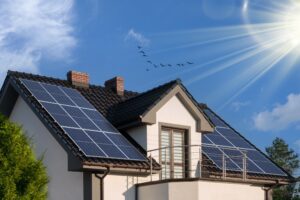An increasing number of homeowners are installing solar panels to generate their own electricity from the sun. This renewable energy cuts electricity bills and reduces carbon emissions that drive climate change.
In most cases, you don’t need planning permission to install solar panels. However, if you live in a listed building, it’s a different matter.
Owning a listed building comes with responsibilities as well as privileges. The obligations include adhering to stricter planning controls such as rules and restrictions on solar panels which are aimed at preserving the character of properties with historical or architectural significance. This protects their rich heritage for the benefit of future generations.
Find out here how listed building regulations affect solar panel installation.
What Is a Listed Building?
Nearly 500,000 properties of national importance are registered on the Statutory List of Buildings of Special Architectural or Historic Interest. They can’t be extended, altered or demolished without permission from the local planning authority, usually in consultation with a government agency.
Many listed buildings have survived down the centuries in more or less their original condition. Others were constructed more recently.
Buildings on the original statutory list were properties built before 1700 and up to 1840. As listed building criteria became tighter over time, it included properties constructed much later, as long as they’re more than 30 years old.
A tiny percentage of listed buildings are structures such as churches or castles, but the vast majority are properties still likely to be in current residential use.
Listed Building Energy Issues
Living in a listed building has its benefits. Many of these properties are visually appealing and located in idyllic settings. They’re also full of character, packed with charming original features such as wooden beams, open fireplaces, and stone mullion windows.
But there can be some drawbacks as well. Many old buildings have poor energy efficiency ratings, and powering and heating them can be a challenge. The result is often eye watering bills, especially at times of inflated energy prices.
In some senses, installing solar panels would be an ideal solution, cutting energy costs by up to 70%, but for these sorts of historic buildings, it’s not that simple.
Most homeowners in regular properties can install solar panels without having to trouble planning officials. Since April 2008, solar panels have been considered a permitted development, so planning permission is generally no longer needed.
Listed buildings, however, are an exception to the rule. This doesn’t necessarily rule out a solar installation completely, but the process is usually more complicated.
Is My Home a Listed Building?
The older your home, the more likely it is to be listed as having special historic or architectural significance.If you’re planning a solar energy installation and are unsure whether your home is a listed building, you can check the National Heritage List for England (NHLE). This is the official register of all listed buildings in England.
In other regions of the UK, you can use databases such as:
- British Listed Buildings.
- Historic Environment Scotland.
- Cadw in Wales.
- Northern Ireland Environment Agency.
- Create a Tailored Quote Based On Your Circumstances
- Takes Less Than 2 Minutes
- Fixed-Online Quotes

Requirements for Listed Building Solar Panels
- If you own a listed property, you will need listed building consent (LBC) to install solar panels. This applies to panels in the grounds or on another building in the grounds, as well as on the roof of the main property.
- First, the local planning authority will check to confirm the building has been properly maintained so far.
- Then you’ll have to demonstrate that your solar panels won’t cause major structural damage or significantly alter the building’s appearance or character.
- In addition, the installation must be easily reversible and the property’s appearance left substantially the same if the solar panels are removed.
- You also need to consider the location of the solar installation electrical system and meter. Ideally, these should be installed somewhere out of sight.
- Solar panels installed on roofs provide optimal efficiency but won’t be an option for listed buildings with a thatched roof or some other types of traditional materials.
- In these cases, the garden or an outbuilding may provide an alternative location for the solar installation.
- Once you have listed building consent, you’ll need to apply for special planning permission for any associated construction work that may be required.
- According to Historic England, which champions the nation’s rich historic legacy, listed building rules and restrictions on solar panels are aimed at striking the best balance between energy efficiency and maintaining heritage significance.
Applying for Listed Building Consent for Solar Panels
Local councils deal with applications for listed building consent, including those for solar panels. It usually takes six to eight weeks to get a decision.
Paper application forms are available from the council offices or you can download them from the council’s website. Alternatively, you can apply via the government Planning Portal.
Professional solar energy technicians can offer advice on the process of applying for listed building consent and any other planning permissions that may be necessary.
Taking aesthetics into account alongside technical aspects, they’ll also be able to tell you the best location for your solar panels, meter, and circuitry. This will increase the likelihood of getting permission to do the work.
Applying for listed building consent is imperative if you want to install solar panels. Failure to do this is a criminal offence. Besides the risk of prosecution, the planning authority can insist on removal of the solar panels after they have been installed.
On the other hand, with listed building consent you’ll have peace of mind as you enjoy all the benefits of solar panels safe in the knowledge that your solar array will not cause you to fall foul of the law..
Solar panels are particularly beneficial in cutting energy bills in an older property. They typically last 25 to 30 years — sometimes even longer for modern panels — with minimal maintenance and pay for themselves much sooner. Plus they generate green energy that minimises environmental impact and contributes to a sustainable future.
Effective Home Listed Building Solar Panel Installations
Effective Home, national specialists in residential energy efficiency solutions, can offer advice on solar panel installation for your listed building. You can rest assured we’ll install your solar panels to conform to all regulations, including listed building rules and restrictions.
We can do this because we know how to install listed building solar panels and associated components discreetly and with minimal structural disruption.
Contact us online or call 0333 003 0703 to schedule a free survey.
- Create a Tailored Quote Based On Your Circumstances
- Takes Less Than 2 Minutes
- Fixed-Online Quotes




